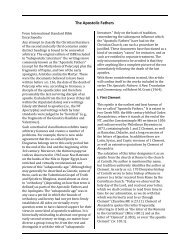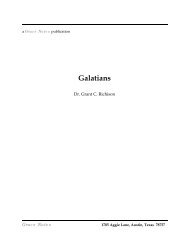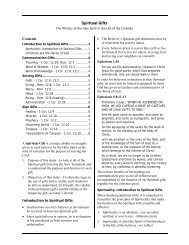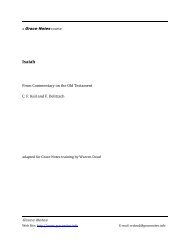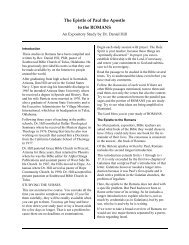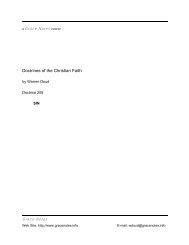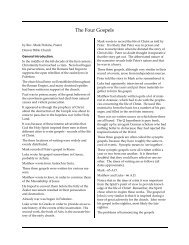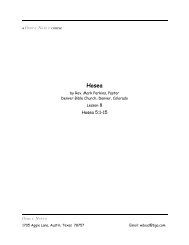Song of Solomon - Grace Notes
Song of Solomon - Grace Notes
Song of Solomon - Grace Notes
Create successful ePaper yourself
Turn your PDF publications into a flip-book with our unique Google optimized e-Paper software.
SONG OF SOLOMON Page 47By C. F. Keil and F. Delitzscha <strong>Grace</strong> <strong>Notes</strong> study3b Like a piece <strong>of</strong> pomegranate thy templesBehind thy veil.is the thin piece <strong>of</strong> the skull on both sides <strong>of</strong> רַ קָ הthe eyes; Lat., mostly in the plur., tempora;German, schläfe, from schlaff, loose, slack, i.e.,weak = ק .רַ The figure points to that s<strong>of</strong>t mixing<strong>of</strong> colours which makes the colouring <strong>of</strong> the socalledcarnation one <strong>of</strong> the most difficultaccomplishments in the art <strong>of</strong> painting. The half<strong>of</strong> a cut pomegranate (Jer. fragmen mali punici)is not meant after its outer side, as Zöcklersupposes, for he gives to the noun răkkā,contrary to Judg. 4:21; 5:26, the meaning <strong>of</strong>cheek, a meaning which it has not, but after itsinner side, which presents a red mixed andtempered with the ruby colour,—a figure somuch the more appropriate, since the groundcolour<strong>of</strong> Shulamith’s countenance is a subduedwhite. Up to this point the figures are borrowedfrom the circle <strong>of</strong> vision <strong>of</strong> a shepherdess. Nowthe king derives them from the sphere <strong>of</strong> hisown experience as the ruler <strong>of</strong> a kingdom. Shewho has eyes like doves is in form like a bornqueen.4 Like the tower <strong>of</strong> David thy neck,Built in terraces;Thereon a thousand shields hang,All the armour <strong>of</strong> heroes.<strong>Song</strong> 4:4. The tower <strong>of</strong> David, is, as it appears,“the tower <strong>of</strong> the flock,” Mic. 4:4, from whichDavid surveyed the flock <strong>of</strong> his people. In Neh.3:25f. it is called the “tower which lieth outfrom the king’s high house,” i.e., not the palace,but a government house built on Zion, whichserved as a court <strong>of</strong> justice. But what is themeaning <strong>of</strong> the ἁπ. λεγ. לְׁ פִ יות ?ּתַ Grätz translates:for a prospect; but the Greek ηλ π ς, <strong>of</strong> whichhe regards תל׳ as the Heb. abstr., is a word sorare that its introduction into the Semiticlanguage is on that account improbable. Hengst.translates: built for hanging swords; and he,ּתָ לָ ה (from ּתַ ל sees in the word a compound <strong>of</strong>with which forms such as יָד = jadj, שַ ד = shadj,but this ;פִ יות 2 Sam. 6:7, are compared) and ,שַ לlatter word signifies, not swords, but edges <strong>of</strong>the (double-edged) sword; wherefore Kimchi(interpreting תַ ל as the constr. <strong>of</strong> ל ,תֵ as ל ,אַ insharp- explains: an erection <strong>of</strong> (צֵ ל is <strong>of</strong> ,בְׁ צַ לְׁ אֵ לcornered stones; and, moreover, the Heb.language knows no such nmm. comp.appellativa: the names <strong>of</strong> the frog, פַ רְׁ דֵ ע ,צְׁ andthe bat, לֵ ף (cf. the Beth in [Arab.] sa’lab, fox,with the added Pe), are not such; and alsotsalmāveth, the shadow <strong>of</strong> death, is at a laterperiod, for the first time, restamped as suchfrom the original tsalmuth (cf. Arab. zalumat =tenebrae). Gesen. obtains the same meanings;for he explains לתל׳ by exitialibus (sc.,, armis),עֲ טַfrom an adj. לְׁ פִ י ,ּתַ from ּתָ לַ ף = Arab. talifa, toperish, the inf. <strong>of</strong> which, talaf, is at the presentday a word synon. with halak (to perish);(Arab.) matlaf (place <strong>of</strong> going down) is, likea poetic name <strong>of</strong> the wilderness. The ,ישימוןexplanation is acceptable but hazardous, sinceneither the Heb. nor the Aram. shows a trace <strong>of</strong>תלף׳ this verb; and it is thus to be given up, ifcan be referred to a verbal stem to be found inthe Heb. and Aram. This is done in Ewald’sexplanation, to which also Böttcher and Rödig.give the preference: built for close (crowded)troops (so, viz., that many hundreds orthousands find room therein); the (Arab.) verbaff, to wrap together (opp. nashar, to unfold), isused <strong>of</strong> the packing together <strong>of</strong> multitudes <strong>of</strong>troops (liff, plur. lufuf), and also <strong>of</strong> warlikehand-to-hand conflicts; תלף׳ would be traced toa verb לָ פָ ה synon. therewith, after the formwere meant <strong>of</strong> troops, then תלף׳ But if .ּתַ אֲ נִיָהthey would be denoted as the garrison foundtherein, and it would not be merely said thatthe tower was built for such; for the point <strong>of</strong>comparison would then be, the imposing look<strong>of</strong> the neck, overpowering by the force <strong>of</strong> theimpression proceeding from within. But now, inthe Aram., and relatively in the Talm. Heb., not,(אַ לְׁ פִ י (Af. לְׁ פִ י occur, but also לּוף and לָ פַ ף onlyand that in the sense <strong>of</strong> enclosure, i.e., <strong>of</strong> joiningtogether, the one working into the other,—e.g.,



